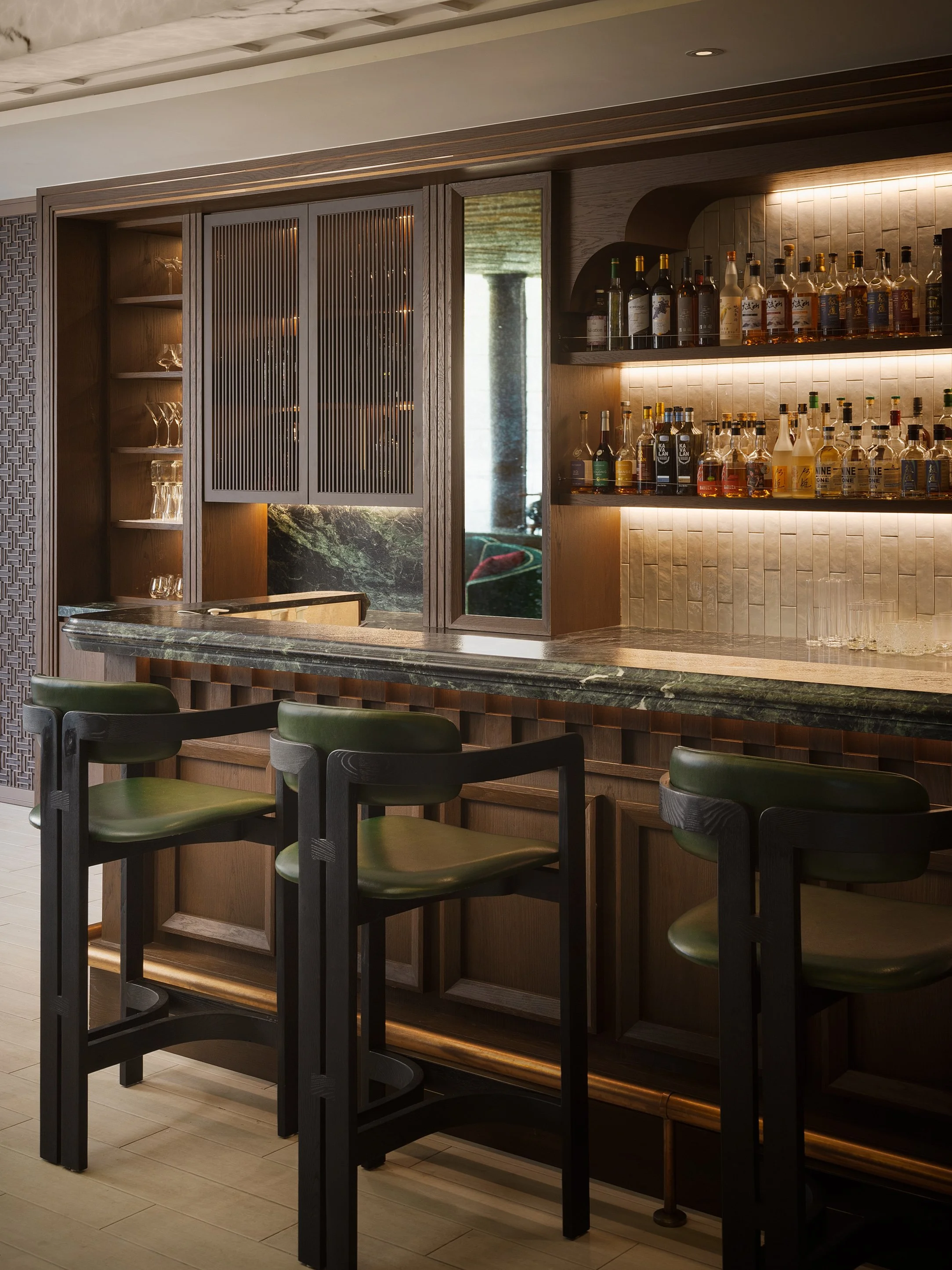JACOB'S DREAM
弈夢紅樓
JACOB'S DREAM
上海,是無法以座標定位的城市。
上海存在,據說但不限於歷史的風流、十里洋場的喧騰,與摩登迷離的風情;它是開放的貿易之城,交換的卻不僅是金錢與貨品,它不斷召喚人們謠傳的記憶,懷揣紛紛的想像與慾望。上海是朦朧卻又具象的概念,是新與舊的永恆,是懸浮流動的夢影。但若想淋漓盡致地感受上海的傳奇,莫過於杯觥交錯間,以舌尖味蕾品嚐匯聚各方菜系的佳餚。
Shanghai is a city that defies the precision of coordinates.
It exists—not merely in its storied past, the electric pulse of the Bund, or the sleek seduction of modernity—but as an open trading port where exchanges transcend currency and commodities. It lingers in the echoes of memories, woven with imagination and desire.
Shanghai is both elusive and tangible, an eternal interplay of the old and the new, a dreamlike silhouette that drifts and unfolds. Yet, to truly grasp its essence, nothing compares to the symphony of flavors that converge at the table—where culinary traditions collide, glasses clink, and the city’s legacy is savored, one exquisite bite at a time.
-
藏身於信義區頂級商務酒店 —— 瀚寓酒店的二樓, 《弈夢紅樓》以上海菜、縱橫港滬商場酒席的粵菜、江浙菜、川菜、乃至在地台菜與義式冰淇淋等,再以RED Bar 的台灣風土調酒佐餐,譜寫出一個家族情牽海派風味的輾轉歷史。
源於創辦人白石集團董事長馬維欣的兒時記憶,馬維欣的祖父是京劇名伶馬繼良,曾以西門紅樓的八角樓作為滬園劇院演出;《弈夢紅樓》菜譜酒單上的懷舊兼容與創新,不僅暗藏了上海匯聚四方的埠式飲食文化,呈現出歷史與地緣脈絡的多面性,也是情懷傳承的延續伏筆。
步入《弈夢紅樓》的空間,恍若揭開時光的帷幕。
沈郁的木質調,可追溯自 19 世紀上海最初的英國租界,內斂雋永的英式風格滲入端莊持重的中式靈魂,成為中西美學初會融合的底蘊。軟裝主導的設計團隊,在原來略顯開放的平面空間中,運用對稱的羅馬柱、中式鏤空雕花屏風與面板、藤編的椅面,劃出輕重層次與虛實掩映的區域氛圍,亦為用餐空間留有適當的隱密性。
酒吧壁面乳白的復古燒窯磚,閃爍溫潤的光澤,環繞空間上方的大型橢圓弧形雲母石主燈,隱隱浮動現代的氣息;吧檯面松綠色的蛇紋石採用典雅的法國飾邊,映襯著座椅墨綠的皮面。
JACOB’S DREAM is nestled on the second floor of Hanns House in Taipei’s vibrant Xinyi District, offering a culinary narrative that spans Shanghai’s rich gastronomic heritage, the refined Cantonese flavors favored in business circles from Shanghai to Hong Kong, and the delicate traditions of Jiangsu and Zhejiang cuisine. Infused with the bold, numbing heat of Sichuan, the comforting warmth of local Taiwanese delicacies, and the indulgence of artisanal Italian gelato, the menu is a symphony of cultures. Complementing these flavors, the RED Bar curates cocktails inspired by Taiwan’s terroir, seamlessly weaving a story of a family’s profound connection to the tastes of Shanghai.
The essence of JACOB’S DREAM is deeply personal, rooted in the childhood memories of its founder, Ma Weixin, Chairman of Glory Stones. His grandfather, the esteemed Peking opera performer Ma Jiliang, once graced the stage of the Bajiao (Octagon) Building within The Red House, a historic venue of the Hu Yuan Theatre. This rich cultural lineage breathes life into the restaurant’s philosophy, where nostalgia and innovation converge. Each dish and cocktail is more than a tribute to Shanghai’s layered culinary influences; it is a continuation of an emotional legacy—a reflection of history, geography, and the intimate connection between food and memory.
Stepping into JACOB’S DREAM is akin to drawing back the curtain of time. The interiors pay homage to 19th-century Shanghai, where the dignified refinement of British colonial design intertwined with the poetic depth of Chinese culture, forming the early fusion of East and West. The design team masterfully sculpts the space, employing symmetry and contrast to define its rhythm—Roman columns stand in quiet equilibrium, offset by intricately carved Chinese screens and panels, while rattan seating introduces a tactile softness, striking a balance between intimacy and openness.
At the bar, the interplay of textures and tones creates a scene of understated elegance. The back wall, clad in milky white vintage kiln-fired bricks, glows with a gentle luminescence, while overhead, a floating oval mica stone suspension lamp casts a subtle, modern aura. Below, the serpentine stone countertop in a deep pine green edged with French trim, harmonizes with the rich emerald leather seating, exuding a quiet sophistication.
_
海派文化講「腔調」,講人情世故的「場面」,而粵式酒席是就是講究派頭的宴客之道。宴客區的中式圓桌襯上精白的西式桌布,圍繞著暖橙色的新古典式餐椅,點綴上幾盞玲瓏剔透的玻璃吊燈,顯得摩登復古且洋氣。
Shanghai culture places great emphasis on “tone”—a refined sensibility that encompasses both taste and etiquette, particularly in social gatherings—while Cantonese banquets celebrate the artistry of hosting with effortless flair.
In the banquet area, traditional Chinese round tables, elegantly draped in crisp white Western tablecloths, serve as a canvas where East meets West. Encircled by warm orange neoclassical dining chairs and illuminated by delicately crafted glass pendant lights, the space exudes a harmonious blend of retro-modern charm and understated sophistication.
_
另一側的用餐區,黛綠色的絲絨弧形沙發勾勒粉白滾邊,在開放區域以軟裝營造有如舒適親密的高雅包間。牆面芭蕉葉的浮雕壁紙,色紋淡雅如青玉;裝飾上鎏金飾邊的幾何掛鏡,並選用對稱、層次的排式壁燈,在立面上疊加反射的材質。柔和的光暈、自然紋理、古典弧線與幾何線條,交織優雅奢華的氛圍。
如同張愛玲筆下精心描摩上海與香港中西合璧的風尚: 『缀有小绒球的墨綠洋式窗簾』、『乳黃色球形玻璃罩』…… 總愛給室內空間、給每一件裝飾擺件著色,《弈夢紅樓》空間中的材質、色彩以及裝飾細節,以細膩的手法,堆疊出肌理豐富,充滿 30、40 年代上海租界風情的 Art Deco 裝飾藝術風格;以空間述說了風格之下,關於迷戀一個時代的萬種風情。
In another side of dining area, malachite green velvet curved sofas are outlined with powder white piping, creating an ambiance akin to a comfortable and intimate private room through soft furnishings in the open space. The walls are adorned with banana leaf embossed wallpaper, featuring subtle color patterns reminiscent of jade; geometric mirrors with gilded edges serve as decorative elements, complemented by symmetrically arranged wall sconces that layer reflective materials on the surfaces. The interplay of soft light, natural textures, classical curves, and geometric lines weaves an atmosphere of elegant luxury.
Much like the meticulous depictions of the fusion of Eastern and Western styles in the works of Eileen Chang, with descriptions such as “dark green Western-style curtains with small pom-poms ”, and “pale yellow spherical glass lampshades”… Eileen Chang tends to infuse color into interior spaces and every decorative piece. The materials, colors, and decorative details within the space of JACOB’S DREAM are intricately layered, rich in texture, and embody the Art Deco style that reflects the charm of the Shanghai concession of the 1930s and 1940s. The space narrates the multiple faces of an era, steeped in a fascination with its distinctive style.
Interior Design|TT Design / MOYA ARTERIOR
FF&E Design| MOYA ARTERIOR
Photography |Wu GuoHao
Editor |Yuwei Tseng



